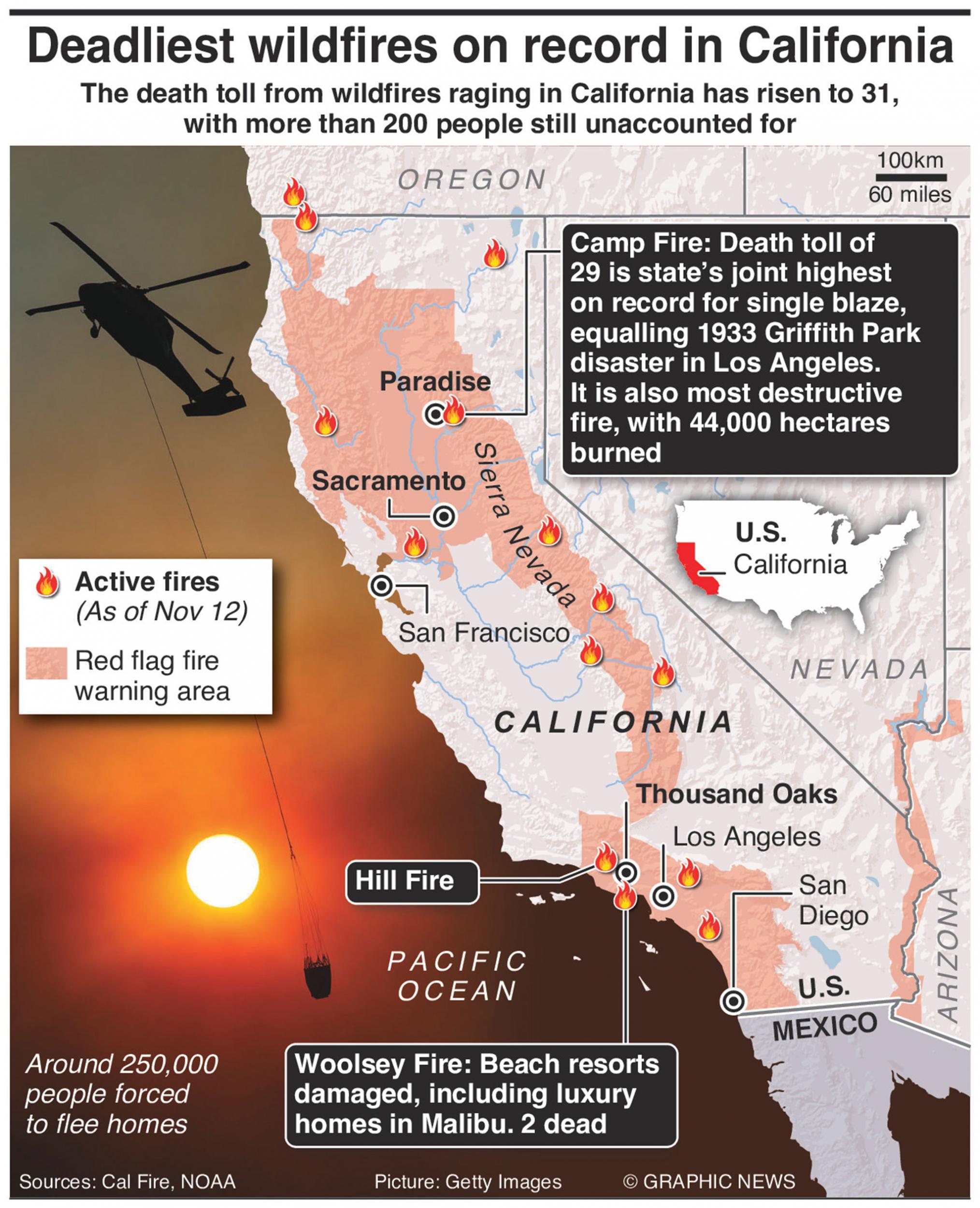California wildfires: 42 dead as blaze becomes deadliest in state history - and conditions could get worse
Camp Fire is most destructive California has seen, with at least another two dead in separate Woolsey blaze
Your support helps us to tell the story
From reproductive rights to climate change to Big Tech, The Independent is on the ground when the story is developing. Whether it's investigating the financials of Elon Musk's pro-Trump PAC or producing our latest documentary, 'The A Word', which shines a light on the American women fighting for reproductive rights, we know how important it is to parse out the facts from the messaging.
At such a critical moment in US history, we need reporters on the ground. Your donation allows us to keep sending journalists to speak to both sides of the story.
The Independent is trusted by Americans across the entire political spectrum. And unlike many other quality news outlets, we choose not to lock Americans out of our reporting and analysis with paywalls. We believe quality journalism should be available to everyone, paid for by those who can afford it.
Your support makes all the difference.Firefighters are searching for more than 200 missing people as they battle three major wildfires ripping through California, leaving thousands displaced and at least 44 dead.
Fierce, dry winds were expected to fan the wildfires into Tuesday, heightening the risk of fresh blazes from scattered embers as investigators fear an increasing death toll.
The Camp Fire, the state’s deadliest and most destructive blaze on record has left at least 42 people dead and 228 people missing, according to local sheriff Kory Honea. Late on Monday, President Donald Trump said he had approved a major disaster declaration for the state.
Speaking on CNN, Mr Honea said that while he holds out hope that many people listed as missing will turn up safe, “given what we’ve dealt with so far with casualties as a result of this fire, I have concerns that it [the death toll] will rise”.
Meanwhile, countless residents have shared images online of missing loved ones, begging people to help them find displaced relatives and friends.
Located 40 miles north of Sacramento, the Camp Fire has destroyed more than 7,100 homes and businesses in the town of Paradise – more structures than any other wildfire recorded in California.

Along with another massive blaze in the southern region of the state, the Woolsey Fire, the wildfires have so far killed at least 44 people. Both have been whipped up by hot dry winds expected to continue through Tuesday evening, officials have predicted.
A smaller blaze in southern California, the Hill Fire, was 75 per cent contained and had burned 4,531 acres, officials said.
The northern fire had scorched more than 111,000 acres and was just 25 per cent contained by late Sunday, officials said. Its death toll of 42 exceeds that of the Griffith Park Fire in 1933, the deadliest wildfire on record in California.
In southern California, the Woolsey Fire had forced authorities to issue evacuation orders for 200,000 people in Ventura and Los Angeles counties and beachside communities including Malibu. At least 370 structures have been destroyed
However, by Sunday night parts of the two counties had been reopened. But many residents returned to their houses to face homes reduced to nothing.
“It’s not the house, because you can rebuild. But it’s what is inside the house. It’s all gone,” Malibu resident Marcella Shirk, 82, told local station KABC-TV. “And that’s what hurts, those kinds of things hurt, because you can’t replace that.”
She and her husband lost their house of 41 years and its possessions – it was reduced to ash on his 92nd birthday.
Many of those allowed to return were left without power or mobile phone service, even if their homes were spared by the flames.
The number of people missing in the Woolsey Fire was not immediately available.
Wind gusts of up to 60 miles per hour (100 km) were expected in the mountains, valleys and canyons of southern California, raising the possibility of downed power lines and trees. This, in combination with low humidity, was expected to create the perfect conditions for fires to spread.
“Winds are already blowing,” Chief Daryl Osby of the Los Angeles County Fire Department warned. “They are going to blow for the next three days. Your house can be rebuilt but you can’t bring your life back.”
The Woolsey Fire has burned at least 91,572 acres and destroyed 370 structures. The blaze was only 20 per cent contained as of Monday. At least two people have died in that fire, according to officials from the statewide agency Cal Fire, which has more than 3,200 personnel fighting the blaze.
“Favourable overnight weather conditions contributed to minimal fire growth, which allowed crews to reinforce containment lines,” the agency said on Monday morning.
California governor Jerry Brown had called on Mr Trump to declare a major disaster to bolster the emergency response and help residents recover, and the president has faced harsh criticism for his first response to the fires.
Mr Trump repeatedly criticised the Californian government in tweets over the weekend, blaming poor forest management for the infernos. The criticisms were met with rebuke from Californian officials and the state’s firefighters union, which stressed that now was the time to focus on recovery rather than “partisanship”.
The president has been attacked by his opponents both for politicising a natural disaster and for refusing to engage fully with overwhelming scientific evidence that climate change is to blame for the extent of the devastation.
The Pasadena Fire Association, meanwhile, tweeted: “Mr President, with all due respect, you are wrong. The fires in So. Cal are urban interface fires and have NOTHING to do with forest management. Come to SoCal and learn the facts & help the victims.”
Reuters contributed to this report

Join our commenting forum
Join thought-provoking conversations, follow other Independent readers and see their replies
Comments